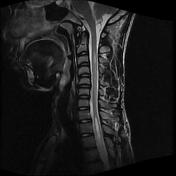60 results
Article
Syringomyelia
Syringomyelia refers to a cystic collection, or syrinx, that occurs within the spinal cord around the central canal.
Terminology
Although syringomyelia is distinct from hydromyelia, in which there is simply dilatation of the central canal, it is very difficult to distinguish the two on imagin...
Case
Syringomyelia

Published
28 Sep 2014
80% complete
MRI
Case
Chiari I malformation with syringomyelia

Published
07 Mar 2012
95% complete
MRI
Case
Scheuermann disease with scoliosis and syringomyelia

Published
24 Apr 2024
92% complete
X-ray
MRI
Case
Syringomyelia

Published
26 Jun 2011
53% complete
MRI
Case
Treated syringomyelia by occipital craniectomy

Published
14 Mar 2012
71% complete
MRI
Case
Chiari 1 malformation with secondary cervicothoracic syringomyelia

Published
21 Jan 2019
77% complete
MRI
Case
Syringomyelia to pleural shunt

Published
08 Jan 2014
54% complete
X-ray
Article
Syrinx
Syrinx (pl. syringes or syrinxes 7) is the collective name given to hydromyelia, syringomyelia, syringobulbia, syringopontia, syringomesencephaly, and syringocephalus.
Terminology
The use of the general term "syrinx" has grown out of the difficulty in distinguishing between hydromyelia and syr...
Article
Syringobulbia
Syringobulbia is a rare entity and refers to a syrinx that extends into the medulla oblongata 1.
Terminology
Some authors use syringobulbia to refer to a syrinx present in any portion of the brainstem rather than specifically involving the medulla oblongata, and therefore encompassing syringop...
Article
Basilar invagination
Basilar invagination, also called basilar impression, is a congenital or acquired craniocervical junction abnormality where the tip of the odontoid process projects above the foramen magnum.
Terminology
The following terms are often used interchangeably because they describe upwards migration...
Article
Hydromyelia
In hydromyelia, there is dilatation of the central canal of the spinal cord. The dilatation is lined by the normal ependymal lining of the central canal.
The term can refer to dilatation of the persistent central canal of the spinal cord which communicates with the fourth ventricle (cavity wall...
Article
Syringopontia
Syringopontia is a rare entity and refers to a syrinx that extends into the pons 1.
Clinical presentation
Patients with this condition demonstrate a wide variety of neurological symptoms localised to the pons, medulla oblongata, and spinal cord, depending on where exactly the syrinx is located...
Article
Syringomesencephaly
Syringomesencephaly is a very rare entity and refers to a syrinx that extends into the midbrain 1.
Clinical presentation
Patients with this condition demonstrate a wide variety of neurological symptoms localised to the brainstem and spinal cord, depending on where exactly the syrinx is located...
Article
Intradural spinal mass lesions (an approach)
Intradural spinal mass lesions are relatively uncommon, compared to intracranial or extradural masses, and can be challenging to diagnose. Additionally, the need for a pre-operative/non-operative diagnosis is in many ways greater as biopsy of lesions within the cord has the potential of devastat...
Article
Spinal pilocytic astrocytoma
Although rare, pilocytic astrocytomas are the most common spinal cord tumours in the paediatric population.
This article specifically relates to spinal pilocytic astrocytomas. For a discussion on intracranial pilocytic astrocytomas refer to pilocytic astrocytoma. For a general discussion on spi...
Article
Anterior spinothalamic tract
The anterior spinothalamic tract, also known as the ventral spinothalamic fasciculus, is an ascending pathway located anteriorly within the spinal cord, primarily responsible for transmitting coarse touch and pressure.
The lateral spinothalamic tract (discussed separately), in contrast, primar...
Article
Lateral spinothalamic tract
The lateral spinothalamic tract, also known as the lateral spinothalamic fasciculus, is an ascending pathway located anterolaterally within the peripheral white matter of the spinal cord. It is primarily responsible for transmitting pain and temperature as well as coarse touch.
The anterior sp...
Article
Craniovertebral junction anomalies
Craniovertebral junction (CVJ) anomalies can be congenital, developmental or due to malformation secondary to an acquired disease process. These anomalies can lead to cranial nerve compression, vertebral artery compression, and obstructive hydrocephalus.
Pathology
The craniovertebral junction ...
Article
Spinal metastasis
Spinal metastasis is a vague term that can be variably taken to refer to metastatic disease to any of the following:
vertebral metastases (94%)
may have epidural extension
intradural extramedullary metastases (5%)
intramedullary metastases (1%)
Each of these are discussed separately. Below ...









 Unable to process the form. Check for errors and try again.
Unable to process the form. Check for errors and try again.